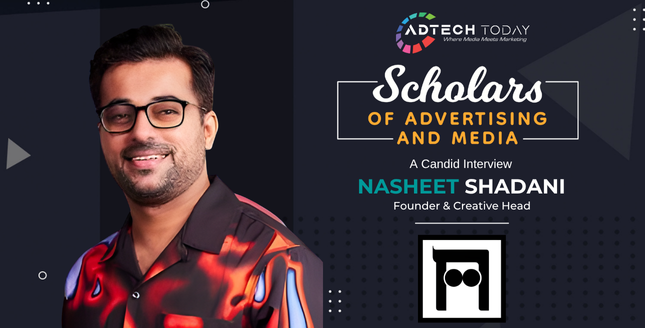
Nasheet Shadani is the Founder and Creative Head of Nash8, a creative agency that crafts bold, mobile-first campaigns for some of India’s leading brands. With over 16 years of experience and 100+ creative awards, he has worked across India and Singapore. Before founding Nash8, he served as a creative strategist at Meta, where he inspired and pushed the industry towards new-age storytelling.
In the interview, Nasheet spoke about the power of human-centric storytelling, balancing creativity with technology, and fostering great teams—urging marketers to take thoughtful risks, stay rooted in craft, and embrace originality in a fast-evolving digital landscape.
You’ve had a long and diverse journey in marketing. Looking back, what guiding principles or beliefs have shaped the way you lead and make decisions?
Three things have guided me. First, the power of a great idea, delivered simply and beautifully, it can move people, shape culture, and solve problems. Second, the belief that hard work is non-negotiable; energy fuels creativity, and creativity drives everything else. And third, never forget that great ideas come from great teams. Individual brilliance matters, but collective energy is what makes things unstoppable.
Marketing creativity often looks different across markets. From your experience, how do you see culture and context shaping the way brands connect with people?
In a mobile-first world, the landscape can feel chaotic, with feeds overflowing and notifications buzzing, everyone fighting for attention. Yet within that chaos, there is a strange order. The brands that cut through are the ones that respect local nuances, not just demographics. It is less about what you say and more about how you say it, in their language, rhythm, and humor. For example, humor that works in one part of India can fall flat in another part of the country. Knowing when to push and when to pause is what makes the difference.
The industry is evolving quickly. What are the biggest opportunities you see today that can help marketers drive meaningful growth?
Every week brings a new curveball: AI updates, performance metrics taking center stage, platforms launching new ad formats overnight. The opportunity is not in chasing every new thing, but in using them to solve real problems without losing craft. And beneath all the hype, the oldest rule still matters most: earning trust. Short-term gimmicks might grab attention, but long-term trust is what builds brands. Growth comes from balance, keeping pace with tech while staying rooted in out-of-the-box thinking.
Every phase of growth brings its own roadblocks. What challenges do you believe the industry needs to address urgently to sustain momentum?
Mediocrity is creeping in as the norm. With content creation easier than ever, the real challenge is standing out while staying true to craft. At Nash8, we believe craft in communication still cuts through noise.
Brands also need to avoid the trap of sounding desperate for attention. Gimmicks might grab short-term eyeballs but often cost more in the long run.
The industry must focus on nurturing young talent, giving fresh voices room to experiment and thrive.
Storytelling itself is evolving, and brands that embrace new-age storytelling rather than clinging to age-old formats are the ones that will truly stand out. Taking thoughtful risks is part of that; every brand wants to be different, but few dare to do something truly new.
AI and automation are transforming the way we work. How do you see the balance between technology and human creativity playing out in the future of marketing?
We are now in an AI-overload age, and finding balance will take time. The risk is letting tools dictate the work instead of the other way around. AI can make anyone a creator, which is both the beauty and the risk. If everyone is making the same templated content, then where is the originality? The real opportunity lies in co-creation, where humans bring intuition and AI brings speed. That is why thinkers, misfits, and innovators are more crucial than ever. Technology should not replace originality, it should sharpen it.
As the digital and mobile-first world reshapes attention spans, what does the next chapter of brand storytelling look like to you?
I think the next chapter might not be about bigger spectacles, but about braver truths. In a world where consumers fact-check brands instantly, the stories that last could be the ones rooted in honesty. Storytelling may also feel more live and unpolished, with moments, formats, and expressions that feel human rather than over-produced. And as AI continues to fill feeds with endless content, the stories that stand out may be the ones that feel unmistakably human.